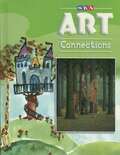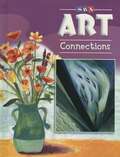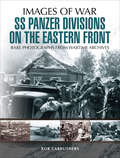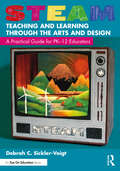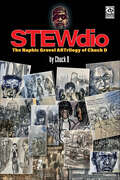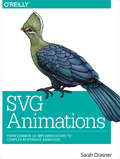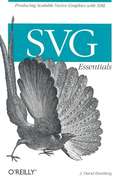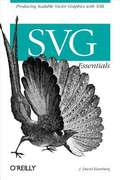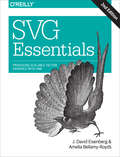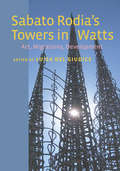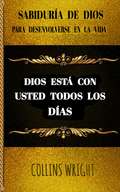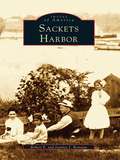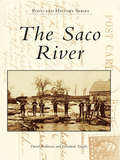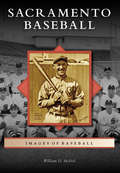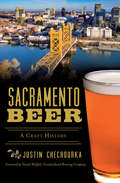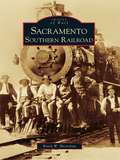- Table View
- List View
SRA Art Connections (Level #1)
by Rosalind Ragans Tina Farrell Jane Rhoades Hudak Gloria Mccoy Bunyan Morris Nan Yoshida Willis DavisArtists make art about many subjects. Name the subjects you see on these pages.
SRA Art Connections (Level #3)
by Rosalind Ragans Tina Farrell Jane Rhoades Hudak Gloria Mccoy Bunyan Morris Nan Yoshida Willis DavisArt is a language. The words of the language are the elements of art.
SRA Art Connections (Level #4)
by Rosalind Ragans Tina Farrell Jane Rhoades Hudak Gloria Mccoy Bunyan Morris Nan Yoshida Willis DavisThe objects you can recognize are the subject matter of a work of art. When a work has no recognizable objects, the elements of art such as lines, shapes, colors, and so on become the subject of the work.
SRA Art Connections (Level K)
by Rosalind Ragans Tina Farrell Jane Rhoades Hudak Gloria Mccoy Bunyan Morris Nan Yoshida Willis DavisArtists create art for many reasons. The artist made Humpty Dumpty Circus so it could be used as a toy.
SS Panzer Divisions on the Eastern Front: Rare Photographs From Wartime Archives (Images of War)
by Bob Carruthers“This book is chock full of striking photographs taken throughout the war, from the invasion of Poland, to the last battles in Hungary . . . a treasure.” —Western Slope Division This book follows the path of the 1st SS Panzer Division “Leibstandarte SS Adolf Hitler,” 2nd SS Panzer Division “Das Reich,” 3rd SS Panzer Division “Totenkopf,” and 5th SS Panzer Division “Wiking” from the opening stages of the war and the challenges of Barbarossa, through to the long and bloody retreat to Berlin. This exceptional collection of images captures the titanic struggle endured by these divisions, and the chain of events they set in motion that proved so critical in shaping the face of the Second World War.Featuring rare images, this is the definitive record of SS Panzer Divisions on the Eastern Front, and an essential addition to any enthusiast’s collection.
STAY: The True Story of Ten Dogs
by Michaela Muntean K. C. Bailey Stephen KazmierskiAn irresistible family of dogs and the man who believed in them. With beautiful full-color photographs, Stay is the story of ten dogs rejected by their owners as hopeless cases and adopted by Luciano Anastasini, a renowned circus performer and dog trainer, who saw hope in every single one of them and gave them new lives as proud, happy circus dogs. These charismatic and talented "puppies," and the journeys that led them to Luciano, are nothing short of incredible. The story is about love, acceptance, and remaining positive even when life gets you down. It is also about family and nurturing and finding one's true self. But most of all, the story is about ten irresistible dogs who will make readers smile and say, "Awwwww. . . "
STEAM Education: Theory and Practice
by Myint Swe Khine Shaljan AreepattamannilThis book looks at the value of integrating the arts and sciences in the school curriculum. It argues that this will help students further their understanding of analytical concepts through the use of creativity. The authors illustrate how schools can work towards presenting common practices, concepts, and content. Coverage features case studies and lessons learned from classrooms across the United States.The notion of STEAM (Science, Technology, Engineering, Arts, and Mathematics) is an emerging discipline unique in its desire to provide a well-rounded approach to education. The chapters of this volume examine STEAM in a variety of settings, from kindergarten to higher education. Readers will learn about the practical considerations involved when introducing the arts and creativity into traditionally left brain processes. This includes best practices for creating and sustaining successful STEAM initiatives in any school, college, or university. For instance, one chapter discusses novel approaches to teach writing with the scientific method in order to help students better present their ideas. The authors also detail how the arts can engage more diverse learners, including students who are not traditionally interested in STEM subjects. They provide three concrete examples of classroom-tested inquiries: designing a prosthetic arm for a child, making a paleontology investigation, and taking a closer look at the arts within roller coaster engineering. This book is an invaluable resource for teachers and teacher trainers, university faculty, researchers, and school administrators. It will also be of interest to science, mathematics, engineering, computer science, information technology, arts and design and technology teachers.
STEAM Teaching and Learning Through the Arts and Design: A Practical Guide for PK–12 Educators
by Debrah C. Sickler-VoigtIn this book, award-winning art educator Debrah C. Sickler-Voigt offers user-friendly, approachable strategies for STEAM planning, instruction, and assessment to help cultivate PK-12 students’ full potential, and draws from wide-ranging artists and designers to help you develop inspired, creative approaches to teaching STEAM in your classroom. Beginning with the basics and best practices of STEAM planning, instruction, and assessment, Sickler-Voigt then encourages readers to move full steam ahead with chapters based around diverse contemporary and historical artists and designers. In helping you to explore the interdisciplinary connections between Science, Technology, Engineering, Arts, and Mathematics, Sickler-Voigt identifies strategies to build off from STEM subjects to form authentic, well-designed, and age-appropriate learning tasks that encourage your students to make deep connections and learn subject matter in context through art media and technologies. Each chapter includes flexible, choice-based classroom resources—with tips for adapting to different grade levels—and STEAM amplifiers, which fuse contextual learning on artists and designers with real-world STEAM topics to spark student learning and ignite creative approaches to planning, instruction, and assessment. Featuring 150 visually stunning, full-color images, this book fuses tried-and-true best practices with highly applicable instructional models inspired by artists and STEAM professionals, ideal for PK-12 teachers and STEAM specialists.
STEM, Theatre Arts, and Interdisciplinary Integrative Learning: Bridging the Cultures (The Arts in Higher Education)
by Nancy KindelanThis book responds to challenging questions about curricular realignment, especially how a more porous approach to higher education reduces the impact of a “siloed” curriculum, lessens the tendency toward the fragmentation of knowledge, allows for the development of cross-disciplinary explorations, and promotes new approaches to knowledge and creativity through interdisciplinary integrative learning. This volume demonstrates how combining two seemingly disparate cultures helps undergraduate students develop creative mindsets needed for addressing challenging open-ended questions, complex social issues, and non-routine problem-solving. In doing so, this book aims to stimulate discussions about integrative interdisciplinary education between STEM and other fields of performance and performance technologies that have been either overlooked or underdeveloped.
STEWdio: The Naphic Grovel ARTrilogy of Chuck D
by Chuck DChuck D (Public Enemy, Prophets of Rage, etc.) brings his personal insights and social critiques to the page in fierce, passionate, and evocative visual art and prose"The Public Enemy mastermind combines art and hip-hop rhymes to provide his compelling, personal views on the chaotic years between 2020 and 2022. Though they often feel like diary entries, each installment has an overarching storyline and theme . . . In an engaging, distinctly hip-hop style, Chuck D reveal important lessons from the early pandemic years." —Kirkus Reviews, Starred ReviewLegendary hip-hop artist and social activist Chuck D has used every opportunity in his groundbreaking career to stand up for civil rights. His rap group Public Enemy is widely regarded as a revolutionary act both in terms of its impact on hip-hop and its use of music to impart a message of race and class equality. The band emerged from the late 1970s/early '80s coalescence of rap, punk, and street art into hip-hop music culture on the East Coast. At the time, Chuck D had completed his BFA in graphic design, and while his music career exploded, his passion for visual art never left his heart.In February 2020, he turned his gaze once again to the page, and began to fill three 5 x 8 journals with his written and drawn reflections of a world beginning to unravel. STEWdio: The Naphic Grovel ARTrilogy of Chuck D recreates format of his original art, combining three full-color paperback bound books into a beautiful box set. The box set is the inaugural offering from Enemy Books, the new Akashic Books imprinted curated by Chuck D.Spanning the onset of COVID-19 through the first year of the Joe "Bye-Don" administration, Chuck D lends his powerful artistic voice to one of the most tumultuous periods in American history, and puts it in a capsule. Like the neo-expressionist graffiti art of Jean-Michel Basquiat, Chuck D's energetic "Naphic Grovels" marry text with drawings, commenting on contemporary events with the same activist instinct that propelled Public Enemy's "music-with-a-message" reputation. His inventive, Amiri Baraka–esque language and accompanying art is also occasionally used as a tool for introspection, providing unparalleled insight into one of the most important cultural figures of our time.Each journal follows a distinct period in Chuck D's (and America's) life; There's a Poison Goin On chronicles the onset of the COVID-19 pandemic, from February–April 2020; 45 Daze of REaD Octobot follow the days leading up to and the aftermath of the historic 2020 election; and Datamber Mindpaper, which focuses on the early days of the Biden administration.No song may be more reflective of 1980s America than Public Enemy's "Fight the Power;" no document may come to capture our COVID era like Chuck D's STEWdio.
STYLE: Photographs for Vogue
by Norman Parkinson'Norman Parkinson will never go out of style' VOGUEMeet the man who invented style. Through his beautiful photographs for British, American, French and Australian Vogue magazines, Norman Parkinson defined the way we saw fashion in 20th century, from the New Look of 1950s Paris to the Swinging Sixties in London.The breathtaking book collects hundreds of Parkinson's greatest photographs taken for Vogue magazine, gathering pioneering fashion shoots, iconic cover images, royal portraits, celebrity pieces and more.Accompanied by detailed captions and features on key models and collaborators – from Grace Coddington and Jerry Hall to Iman and HRH Princess Anne – STYLE: Photographs for Vogue is a sublime, glamorous tribute to an eternally stylish magazine and the dazzling vision of a man who shaped the face of fashion across six decades.
STYLE: Photographs for Vogue
by Norman Parkinson'Norman Parkinson will never go out of style' VOGUEMeet the man who invented style. Through his beautiful photographs for British, American, French and Australian Vogue magazines, Norman Parkinson defined the way we saw fashion in 20th century, from the New Look of 1950s Paris to the Swinging Sixties in London.The breathtaking book collects hundreds of Parkinson's greatest photographs taken for Vogue magazine, gathering pioneering fashion shoots, iconic cover images, royal portraits, celebrity pieces and more.Accompanied by detailed captions and features on key models and collaborators – from Grace Coddington and Jerry Hall to Iman and HRH Princess Anne – STYLE: Photographs for Vogue is a sublime, glamorous tribute to an eternally stylish magazine and the dazzling vision of a man who shaped the face of fashion across six decades.
SUSTAINABLE FEDERAL FACILITIES: A Guide to Integrating Value Engineering, Life-Cycle Costing, and Sustainable Development
by The Federal Facilities Council Ad Hoc Task Group On Integrating Sustainable Design Life-Cycle Costing Value Engineering Into Facilities AcquisitionThis report presents a framework explaining how federal agencies can apply value engineering and life-cycle costing to support sustainable development for facilities, thus meeting the requirements of Executive Order 13123. The report describes the research on which its conclusions are based, details facility life cycles and outlines the acquisition process, describes the acquisition of sustainable facilities, identifies issues, and lists online resources. Flow charts and other diagrams illustrate the processes described in the text. There is no index. Annotation c. Book News, Inc. , Portland, OR (booknews. com)
SVG Animations: From Common UX Implementations to Complex Responsive Animation
by Sarah DrasnerSVG is extremely powerful, with its reduced HTTP requests and crispness on any display. It becomes increasingly more interesting as you explore its capabilities for responsive animation and performance boons. When you animate SVG, you must be aware of normal image traits like composition, color, implementation, and optimization. But when you animate, it increases the complexity of each of these factors exponentially.This practical book takes a deep dive into how you can to solve these problems with stability, performance, and creativity in mind.Learn how to make SVG cross-browser compatible, backwards compatible, optimized, and responsivePlan and debug animationMake a complex animation responsive, as many sites are responsiveProfile each animation technique in terms of performance so that you know what you're getting in to with each library or native technology
SVG Essentials
by J. David EisenbergScalable Vector Graphics -- or SVG -- is the new XML-based graphics standard from the W3C that will enable Web documents to be smaller, faster and more interactive. This insightful book takes you through the ins and outs of SVG, from the basics to more complicated features. Whether you're a graphic designer looking for new tools, or a programmer creating and managing graphics, this book provides a solid foundation.
SVG Essentials
by J. EisenbergScalable Vector Graphics -- or SVG -- is the new XML-based graphics standard from the W3C that will enable Web documents to be smaller, faster and more interactive. J. David Eisenberg's insightful book takes you through the ins and outs of SVG, beginning with basics needed to create simple line drawings and then moving through more complicated features like filters, transformations, and integration with Java, Perl, and XSLT. Unlike GIFs, JPEGs or PNGs (which are bitmapped), SVG images are both resolution- and device-independent, so that they can scale up or down to fit proportionally into any size display or any Internet device -- from PDAs to large office monitors and high-resolution printers. Smaller than bitmapped files and faster to download, SVG images can be rendered with different CSS styles for each environment. They work well across a range of available bandwidths. SVG makes it possible for designers to escape the constant need to update graphics by hand or use custom code to generate bitmap images. And while SVG was created with the Web in mind, the language has a variety of other uses. SVG greatly simplifies tasks like: Creating web sites whose graphics reflect the content of the page, changing automatically if the content changes Generating graphs and charts from information stored in a wide variety of sources Exchanging detailed drawings, from architectural plans to CAD layouts to project management diagrams Creating diagrams that users can explore by zooming in and panning around Generating bitmap images for use in older browsers using simple automatable templates Managing graphics that support multiple languages or translations Creating complex animation By focusing sharply on the markup at the foundation of SVG, SVG Essentials gives you a solid base on which to create your own custom tools. Explanations of key technical tools -- like XML, matrix math, and scripting -- are included as appendices, along with a reference to the SVG vocabulary. Whether you're a graphic designer in search of new tools or a programmer dealing with the complex task of creating and managing graphics, SVG Essentials provides you with the means to take advantage of SVG.
SVG Essentials: Producing Scalable Vector Graphics with XML
by J. David Eisenberg Amelia Bellamy-RoydsLearn the essentials of Scalable Vector Graphics, the mark-up language used by most vector drawing programs and interactive web graphics tools. SVG Essentials takes you through SVG’s capabilities, beginning with simple line drawings and moving through complicated features such as filters, transformations, gradients, and patterns.This thoroughly updated edition includes expanded coverage of animation, interactive graphics, and scripting SVG. Interactive examples online make it easy for you to experiment with SVG features in your web browser. Geared toward experienced designers, this book also includes appendices that explain basic concepts such as XML markup and CSS styling, so even if you have no web design experience, you can start learning SVG.Create and style graphics to match your web design in a way that looks great when printed or displayed on high-resolution screensMake your charts and decorative headings accessible to search engines and assistive technologiesAdd artistic effects to your graphics, text, and photographs using SVG masks, filters, and transformationsAnimate graphics with SVG markup, or add interactivity with CSS and JavaScriptCreate SVG from existing vector data or XML data, using programming languages and XSLT
Sabato Rodia's Towers in Watts: Art, Migrations, Development (Critical Studies in Italian America)
by Luisa Del Giudice&“A rich array of perspectives on the creative work of the eccentric immigrant laborer who created one of the most mysterious landmarks of Los Angeles.&” —Donna Gabaccia, Professor of History, University of Minnesota The Watts Towers, wondrous objects of art and architecture, were created over the course of three decades by a determined, single-minded artist, Sabato Rodia, an Italian immigrant laborer who wanted to do &“something big.&” Now a National Historic Landmark and internationally renowned destination, the Watts Towers in Los Angeles are both a personal artistic expression and a collective symbol of Nuestro Pueblo—Our Town/Our People. Featuring fresh and innovative examinations, Sabato Rodia&’s Towers in Watts revisits the man and his towers. In 1919, Rodia purchased a triangular plot of land in a multiethnic, working-class, semi-rural district. He set to work on an unusual building project in his own yard. By night, Rodia dreamed and excogitated, and by day he built. He experimented with form, color, texture, cement mixtures, and construction techniques. He built, tore down, and rebuilt. As an artist completely possessed by his work, he was often derided as an incomprehensible crazy man. Providing a multifaceted, holistic understanding of Rodia, the towers, and the cultural/social/physical environment within which the towers and their maker can be understood, this book compiles essays from twenty authors, offering perspectives from the arts, the communities involved in the preservation and interpretation of the towers, and the academy. Most of the contributions originated at two interdisciplinary conferences held in Los Angeles and in Italy, and the collection as a whole is a well-rounded tribute to one man&’s tenacious labor of love.A portion of royalties will go to support the work of the Watts Towers Arts Center.
Sabiduría de Dios para Desenvolverse en la Vida: Dios está con Usted Todos los Días
by Collins Wright"Si no está seguro de que un sacerdote o un reverendo use pantalones, espere el día en que un viento fuerte sople su espalda”. Diariamente, lo vemos, lo oímos, lo llevamos a cabo, ya sea que nos demos cuenta o no, porque la existencia misma es proverbial. LA SABIDURÍA DE DIOS PARA DESENVOLVERSE EN LA VIDA sintetiza buenos consejos, advertencias contundentes, conocimiento pleno, verdades evidentes y una moral pura en portadas humorísticas. Dibuja imágenes de experiencias diarias y un mensaje verdadero para las personas de todo el mundo. En ocasiones, se pondrá a reír y sus ojos se llenarán de lágrimas. Descubra por qué “Un niño no tiene la habitación lo suficientemente grande para disfrazar una mentira” y por qué “Un hombre tiene que sostener su órgano con la mano como señal al momento en que se le insinúa a una sordomuda”.
Sackets Harbor
by Robert E. Brennan Jeannie I. BrennanSackets Harbor presents the unique history of a notable community that has achieved prominence as the northern headquarters in the War of 1812, as the home of the celebrated Madison Barracks, and as a revitalized tourist center. Ideally situated on the eastern shore of Lake Ontario in upstate New York, Sackets Harbor attracted the Iroquois, the Algonquin, early white settlers, and military strategists with its bounty. The village took its name from Augustus Sacket, who purchased tracts along the water in 1801 and led the first influx of settlers to the region. By 1809, the village had a military presence, but it was the War of 1812 that put Sackets Harbor on the map. In 1816, it became the site of Madison Barracks, the focus of life in the village until after World War II. Today a mecca for pleasure boating, sports fishing, and relaxation,Sackets Harbor has been dubbed a "hidden treasure."
Saco River, The (Postcard History)
by David Robinson Elizabeth TanefisFrom its source in New Hampshire's White Mountains to its mouth at Saco-Biddeford, the Saco River draws visitors and residents alike to swim, fish, canoe, and white-water kayak. The Saco brought tourists to the White Mountains and influenced the development of both large and small towns, shaping their history and creating bustling centers of industry. The Saco River documents the river through postcards from 1905 to the 1940s, when mills dominated the landscape.
Sacramento
by William BurgCalifornia's capital city, Sacramento, has played many roles over time, including Gold Rush boomtown, railroad terminus, regional industrial center, and seat of state government. These varied roles meant dramatic changes as the city grew outward and upward.
Sacramento Baseball (Images of Baseball)
by William D. McpoilSacramento has enjoyed baseball since the Gold Rush. As early as 1869, the first professional baseball team in America, the Cincinnati Red Stockings, came to Sacramento and played against a locally organized team. A few years later, the Sacramento team joined the California League to compete against those from San Francisco and Oakland, becoming a charter member of the newly formed Pacific Coast League in 1903. All the while, children and adults alike were picking up the sport in the many parks, sandlots, and schoolyards throughout the city. In the 1920s, 1930s, and 1940s, amateur and sponsored teams competed against each other for trophies and bragging rights. Then, in the 1950s, Little League, Babe Ruth League, and American Legion Baseball flourished.
Sacramento Beer: A Craft History (American Palate)
by Justin ChechourkaHistorically speaking, Sacramento benefited from a gold rush, an agricultural boom and, more recently, a brewing renaissance. The region's craft beer scene exploded from six to more than sixty breweries in about a decade, and the roots of that culture stretch back more than a century. Before Prohibition, thousands of acres of local hops supplied brewers across the country. Local farms are once again taking advantage of the temperate climate. In 1958, the University of California-Davis started America's foremost brewing science program, producing some of California's top brewers. Rubicon's 1989 award-winning IPA was just the beginning for the current, innovative resurgence. Author Justin Chechourka explores the complexities and nuance of this fermenting heritage.
Sacramento Southern Railroad
by Kevin HectemanThe Sacramento Southern Railroad was born into a famous railroad family and a busy railroad town in July 1903. The mighty Southern Pacific, which controlled the new line from the outset, built south from Sacramento along the eastern bank of the Sacramento River into the delta's rich farmland area. At its zenith, the line was about 31 miles long, serving the communities of Freeport, Hood, Locke, Walnut Grove, and Isleton. Trains on what became known as the Walnut Grove Branch hauled pears, sugar beets, asparagus and other products from the agricultural region's packing sheds and canneries. Competition from trucking and damage from flooding took a severe toll on the railroad, and the Southern Pacific largely abandoned it by 1978, but a portion lives on as a labor of love.

